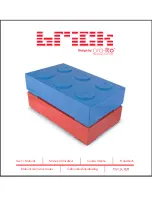
DLTtape™ TAPE UNIT INSTALLATION
DLTtape Tape Drive Configuration on Linux
Overview
Instructions provided here are for configuring and using DLTtape drives under Linux. At Benchmark,
DLTtape drives have been tested under several Linux distributions - including Slackware, Debian, RedHat
and Caldera. We have tried several kernel versions ranging from 2.0.36 through 2.2.10 on Intel platforms of
varying horsepower. The guidelines provided here should apply - with only minor changes required, if any
- to your favorite Linux distribution.
You need a SCSI adapter on the host
If there are existing SCSI disk drives, SCSI CD-ROM or SCSI tape drives configured on your host, then
you already have a SCSI adapter (or built-in interface). After shutting down Linux and powering the
machine off, cable the DLTtape drive to the SCSI adapter. Select a distinct ID for the DLTtape drive on the
SCSI bus. Then power up the drive and place a suitable cartridge in it.
Most of the popular SCSI adapters provide a configuration utility that can be invoked during system
powerup and BIOS scan. Such utilities are handy for verifying that the cabling is good, the host adapter
sees the tape drive, and there are no bus ID conflicts.
You need the Linux driver for your SCSI adapter
If you've been using other devices on your SCSI adapter under Linux, you have this driver already. If
you've just installed a new SCSI card to host the DLTtape drive, you may need to build a Linux kernel that
includes the appropriate driver for your adapter. Your Linux distribution should provide documentation on
how to build and install a new kernel. Reboot from your kernel and make sure that the SCSI adapter driver
sees your DLTtape drive.
dmesg
is useful for examining kernel startup messages.
You need the st driver
st
is the generic SCSI tape driver for Linux. If you have been using other SCSI tape drives on your Linux
system, your kernel already has it. If
st
is in your kernel, you should see a line similar to the following
during Linux bootup for each SCSI tape drive on the system.
Detected scsi tape st0 at scsi1, channel 0, id 0, lun 0
Detected scsi tape st1 at scsi3, channel 0, id 3, lun 0
If you don’t see this, you’ll have to rebuild the kernel with
st
support included. Again, the documentation
that came with your Linux distribution should be a good starting point for this task. After you install the
kernel-source package, make sure to check the
README
files in
/usr/src/linux
for detailed version-
specific rebuild requirements. If you’re going to be rolling your own kernel, read the section below on
Tuning for Performance
first. This is a good time to customize your settings in the
st_options.h
file and
hard-wire them into the Linux kernel. This will save you the bother of passing boot-time options to the
st
driver.
You need device-special files in /dev
Linux provides two device files for each SCSI tape drive in the system:
/dev/sti
and
/dev/nsti
, where i is a
number reference to a particular drive. Drives are numbered from zero on up. Numbering is based primarily
on SCSI bus number (if you have several SCSI adapters) and secondarily on SCSI ID within a bus.
A file-close on
/dev/sti
causes the tape drive to automatically rewind the cartridge. For example, after a
tar
cf
on
/dev/st0
, the drive head will be positioned at beginning of tape. A subsequent
tar cf
on the same





















